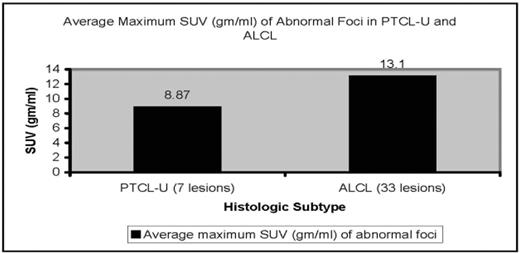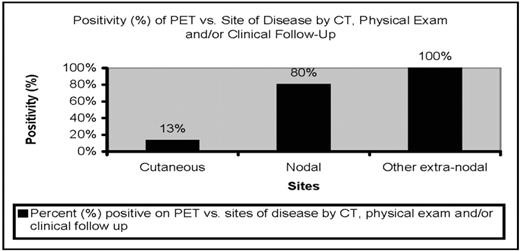Abstract
The sensitivity and specificity of fluorine-18 fluoro-deoxy-glucose positron emission tomography (PET) in the evaluation of peripheral T cell lymphomas (PTCL) is not well established. In this abstract, we describe our experience utilizing PET in the diagnostic evaluation of PTCL.
A retrospective review of 2768 PET examinations conducted at our institutionbetween the years 1999–2006 produced twenty-six examinations among twenty-two patients with a biopsy proven diagnosis of PTCL. All patients underwent staging of their disease using both conventional diagnostic methods and PET. Their therapeutic status was also taken into consideration when interpreting PET examinations. PTCL were classified by World Health Organization (WHO) criteria and included: PTCL-unclassified (PTCL-U), anaplastic lymphoma kinase positive (+) and negative (−) anaplastic large cell lymphoma, gioimmunoblastic (AITL n=1), and natural killer T-cell nasal type (NK/T n=1). PET results for each patient were compared against a standard of reference, and the sensitivity, specificity, negative predictive value (NPV) and positive predictive value (PET) of PET were calculated.
PET had an overall sensitivity of 55% and specificity of 100% in PTCL-U. PET had an overall sensitivity of 83% and specificity of 100% in ALCL. PET had an overall sensitivity of 13% and specificity of 0% in cutaneous PTCL. Among patients with non-cutaneous PTCL-U, the sensitivity and specificity were 83% and 100% respectively. Among patients with non-cutaneous ALCL, the sensitivity and specificity were 100% respectively. Excluding those patients with cutaneous PTCL, PET correlated with clinical outcome in 87% of PTCL-U 100% of ALCL patients. The average maximum standard uptake value (g/mL) of abnormal foci demonstrated greater intensity in patients with ALCL (13.1) than those with PTCL-U (8.87) (Figure 1). PET had excellent correlation with CT, physical examination and clinical follow-up at both nodal and extra-nodal sites, but poor correlation at cutaneous sites (Figure 2).
The PPV and NPV of restaging PET in PTCL-U were 75% and 100% respectively. In ALCL, the PPV and NPV of restaging PET were 66% and 100% respectively.
PET is useful for staging and restaging patients with nodal and non-cutaneous extra-nodal involvement in PTCL-U and ALCL. It demonstrates a comparatively low sensitivity in cutaneous PTCL.
Average Maximum SUV (gm/ml) of Abnormal Foci in PTCL-U and ALCL
Positivity (%) of PET vs. Site of Disease by CT, Physical Exam and/or Clinical Follow Up
Positivity (%) of PET vs. Site of Disease by CT, Physical Exam and/or Clinical Follow Up
Disclosure: No relevant conflicts of interest to declare.
Author notes
Corresponding author



This feature is available to Subscribers Only
Sign In or Create an Account Close Modal